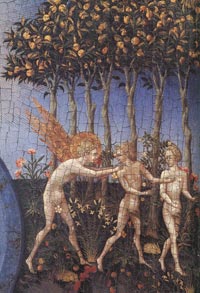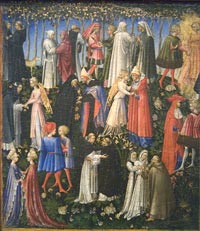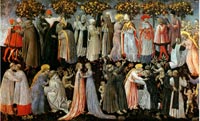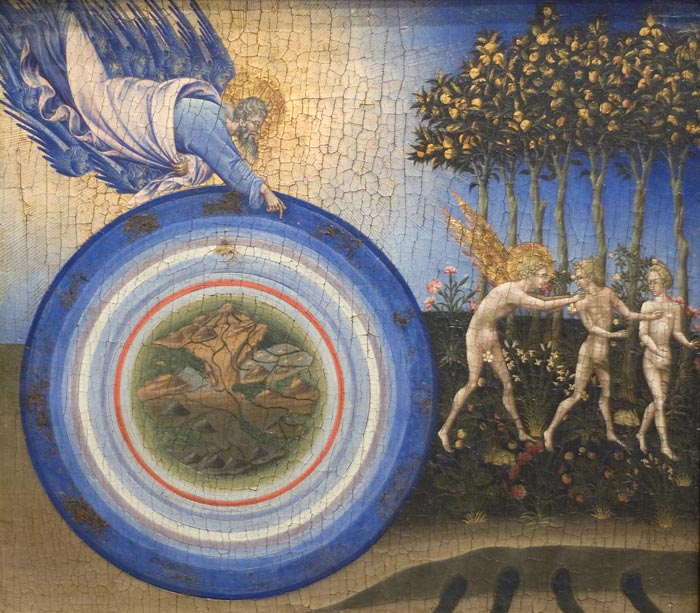 |
Giovanni di Paolo, The Creation and the Expulsion from the Paradise, c. 1445, tempera and gold on wood, 46, 4 x 52,1 cm, Metropolitan Museum of Art, New York |
Giovanni di Paolo |
| Giovanni di Paolo di Grazia, one of the most important Italian painters of the 15th-century Sienese school. He is chiefly notable for carrying the brilliantly colourful vision of Sienese 14th-century paintings on into the Renaissance. His early works show the influence of previous Sienese masters, his landscapes and his figures still reverberate with echoes of Duccio's work, but his later style grew steadily more individualized, characterized by vigorous, harsh colors and elongated forms. His art most beautifully reflects the 15th-century artistic conservatism of a commercially declining city. Many of his works have an unusual dreamlike atmosphere, such as the surrealistic Saint Nicholas of Tolentino Saving a Ship (1455?, Philadelphia Museum of Art), while his last works - particularly Last Judgment, Heaven, and Hell (1465?) and Assumption of the Virgin (1475), both at Pinacoteca, Siena - are grotesque treatments of their lofty subjects. Giovanni's reputation declined after his death but was revived in the 20th century. |
Giovanni di Paolo was an independent artist who managed to thrive in a Siena which was on the one hand conservative and on the other responsive to such inventive minds as Sassetta and the Osservanza Master. Like these artists, Giovanni di Paolo had remarkable narrative gifts as an artist as is clear from such masterpieces as The Life of John the Baptist (Art Institute of Chicago), The Expulsion of Adam and Eve from the Garden of Eden (Robert Lehman Collection, Metropolitan Museum, New York) and the Paradise (Metropolitan Museum, New York). His early training seems to have included contact with Lombard artists (his earliest patron was the Lombard Anna Castiglione a relative of Cardinal Castiglione Branda, patron of Vecchietta) and probably French artists too. He could, for example, have known the Limbourg brothers, the Franco-Flemish illuminators who were in Siena in 1413. Certainly the nervous, staccato quality of line that distinguishes his work from that of his Sienese contemporaries betrays an assimilation of Lombard and French Gothic forms. By the mid 1420s Giovanni di Paolo's career was flourishing and from that period come the Pecci and Branchini altarpieces (Pinacoteca Nazionale, Siena and Norton Simon Museum, San Marino) which both show the influence of Gentile da Fabriano who had painted a (now lost) altarpiece in 1425/6 for the Sienese Notaries Guild. |
| This extraordinary panel is widely admired for its brilliant colours, curious iconography, and mystical vitality At the left, God the Father, supported by 12 blue cherubim, flies downward, pointing with his right hand at a circular "mappamondo", which fills the lower half of the scene. The representation of earth is surrounded by concentric circles, including a green ring (for water), a blue ring (for air), a red ring (for fire), the circles of the seven planets, and the circle of the Zodiac. On the right, in a separate scene set in a meadow filled with flowers, Adam and Eve walk to the right against a line of seven trees with golden fruit. Their heads turn back toward a naked angel, who expels them from Paradise. Below them spring the four rivers of Paradise, which extend to the base of the picture. This panel is a fragment from the predella of an altarpiece painted for the church of San Domenico in Siena and now in the Uffizi in Florence. Another panel from the same predella is also in the Museum's collection. The influence of the International Gothic style, especially French miniature painting, can be seen in the figures of the angel, Adam, and Eve, and in the details of flora and fauna. Art in Tuscany | Giovanni di Paolo, The Creation and the Expulsion from the Paradise |
||
| This exquisite painting and a panel of the "Creation and Expulsion from Paradise" in the Metropolitan (Robert Lehman Collection) were both probably from the predella of an altarpiece formerly on the Guelfi altar in San Domenico, Siena, painted in 1445. In this vision of Paradise, filled with flowers and trees, groups of saints and angels embrace. The composition derives from Fra Angelico's paintings in Florence of the Last Judgment, but its combination of intensity and decorative effect is typical of Giovanni di Paolo's style. The rich floral setting may derive from northern tapestries, much prized in Siena, where a French weaver was employed.
The panels Paradise and the Expulsion from Paradise, both in the Robert Lehman Collection in The Metropolitan Museum of Art, originally formed part of the same predella, that of the altarpiece created for the Dominican chapel in the church of San Domenico, Siena. A "Madonna and Child with Saints Dominic, Peter, Paul, and Thomas Aquinas" (Galleria degli Uffizi, Florence), signed and dated 1445, was the central panel of the altarpiece. One seventeenth-century document [see Ref. Chigi 1625–26] records the date of this altarpiece as 1426; another [see Ref. Ugurgieri Azzolini 1649] records it as 1445, and describes the subject as a Madonna with saints, with a predella depicting the Last Judgment, the Flood, and the Creation of the World. The two MMA works can both be dated about 1445 on stylistic grounds. The Lehman panel would have formed the left-most predella panel, representing the Creation and Expulsion, next would have come Paradise, followed by the Last Judgment, Hell, and the Flood. [see Refs. Pope-Hennessy 1937 and Strehlke 1988 for detailed discussions of these issues] Identifiable figures in this depiction of Paradise include Saint Giles at the upper left, dressed in white, with a deer behind him; Beato Ambrogio Sansedoni, a patron of Siena, at the middle left, dressed in the black and white Dominican habit, with a white dove near his head; Saint Augustine with his mother, Saint Monica, greeting each other at the center, she an old woman in black, he a bishop; Saints Dominic and Peter Martyr at the lower center, both in the Dominican habit; and Saint Anthony Abbot at the bottom right with two Dominican nuns. The paint surface has been cut on the right side, where a painted border has been added over remnants of the original composition to make the scene appear complete. There are traces of the original border on the other three sides. Despite transfer, much of the original appearance of the surface of the picture is preserved due to the artist's use of a canvas between the panel and the gesso; this canvas was transferred with the paint surface. |
||
| Giovanni di Paolo's brilliant color and pattern were typically Sienese, but he is distinguished from his teachers and contemporaries by an expressive imagination. His unique style is otherworldly and spiritual. Here the drama is heightened by a dark background and contrasting colors, nervous patterns, and unreal proportions. In the center, Gabriel brings news of Christ's future birth to the Virgin. Thus is put in motion the promise of salvation for humankind, a salvation necessitated by the expulsion of Adam and Eve from Paradise, which we see happening on the left, outside Mary's jewellike home. Mary will reopen the doors of Paradise closed by Eve's sin. The scene of Joseph warming himself in front of a fire, on the right, is an unusual addition. Perhaps it refers simply to the season of Jesus' birth, but more likely it is layered with other meanings, suggesting the flames of hope and charity and invoking the winter of sin now to be replaced by the spring of this new era of Grace. The three scenes help make explicit the connection between the Fall and God's promise of salvation, which is fulfilled at the moment of the Annunication. Though Giovanni's primary concern is not the appearance of the natural world, it is clear that he was aware of contemporary developments in the realistic depiction of space. Note how the floor tiles appear to recede, a technique adopted by Florentine artists experimenting with the new science of perspective. Art in Tuscany | Giovanni di Paolo | The Annunciation and Expulsion from Paradise |
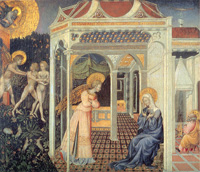 The Annunciation and Expulsion from Paradise, circa 1435, National Gallery of Art, Washington D.C. |
|
Giovanni di Paolo, |
||
|
|
British Library Catalogue of Illuminated Manuscripts | Dante Alighieri | Divina Commedia, between 1444 and c. 1450 | Inferno and Purgatorio (ff. 1-128), and all historiated initials illuminated by Priamo della Quercia between 1442 and 1450 (previously attributed to Lorenzo Vecchietta; Paradiso (ff. 129-190v) illuminated by Giovanni di Paolo c. 1450. John Wyndham Pope-Hennessy, Paradiso: The Illuminations to Dante's Divine Comedy by Giovanni Di Paolo, New York, Random House, 1993. Dante's Divine Comedy has inspired artists from Giotto down to the present. Perhaps among the most beautiful illustrations are those of the 15th-century Sienese painter Giovanni di Paolo, who illuminated a Paradiso manuscript for the library of the King of Naples, now in the British Library as Yates-Thompson MS 36. Pope-Hennessy, the noted British art historian, presents reproductions of di Paolo's 61 illuminations in a large format and in full color. He includes a lucid historical introduction and a commentary on the content of each of the miniatures. The book also includes Charles Singleton's prose translation of the Paradiso . H. W. van Os, Giovanni di Paolo's Pizzicaiuolo Altarpiece, The Art Bulletin, Vol. 53, No. 3 (Sep., 1971), pp. 289-302 |
The wonderful property Santa Pia is situated in the middle of the Maremma area. Ideal for a relaxing holiday in this charming wine growing region.. With its original kitchen and the wood burning pizza oven, Santa Pia offers an upbeat atmosphere. One can fire-up the wood-burning oven & make pizza from scratch. Tuscan Holiday houses | Podere Santa Pia |

